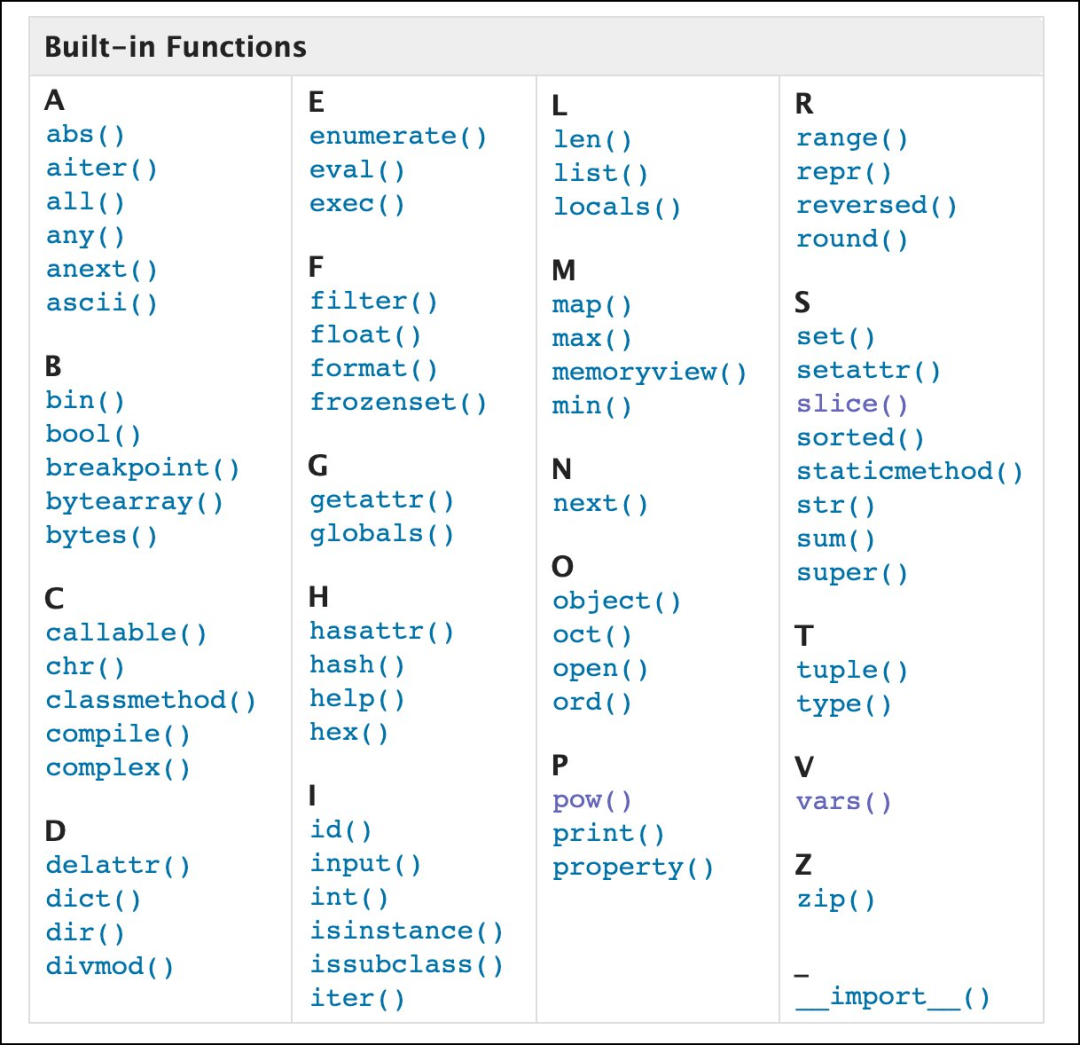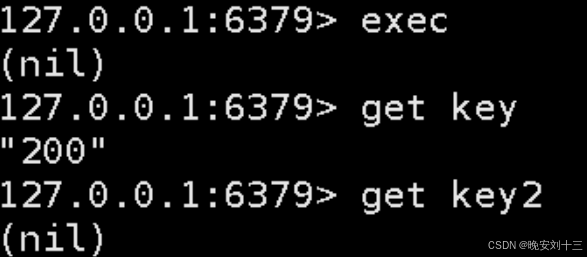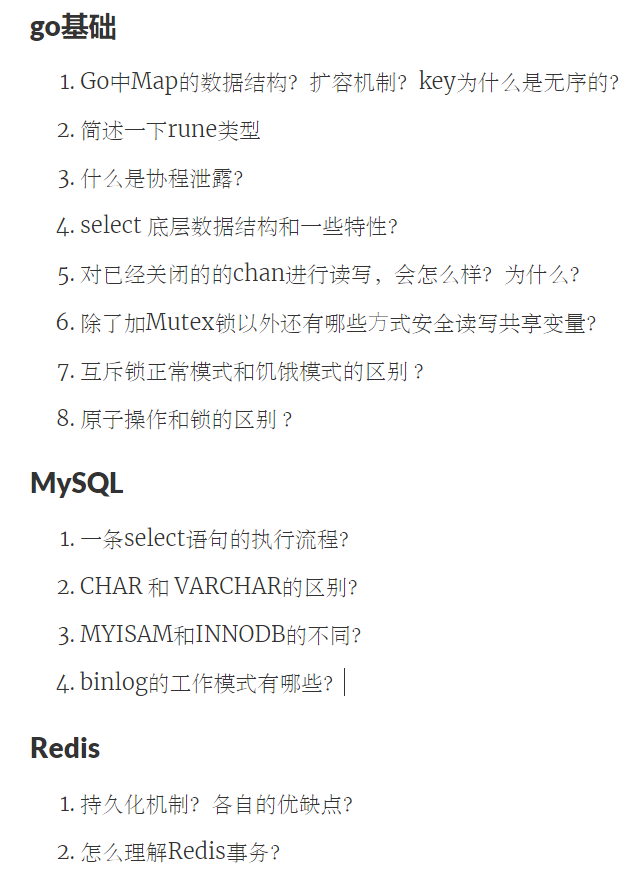

Python中的内置函数,这些函数覆盖了从基本数据处理到高级编程功能的各种用途。下面,将逐一介绍每个函数的用途和提供相应的代码示例。
A
- abs():返回数字的绝对值。
print(abs(-5)) # 输出: 5
- aiter():返回异步迭代器。
async def async_iter():
for i in range(3):
yield i
async for value in aiter(async_iter()):
print(value) # 输出: 0, 1, 2
- all():判断给定的可迭代参数 iterable 中的所有元素是否都为 TRUE。
print(all([True, True, True])) # 输出: True
- any():判断给定的可迭代参数 iterable 是否有任一元素为 TRUE。
print(any([False, True, False])) # 输出: True
- anext():返回异步迭代器的下一个元素。
async def async_iter():
for i in range(3):
yield i
aiter_obj = aiter(async_iter())
print(await anext(aiter_obj)) # 输出: 0
- ascii():返回对象的可打印表示形式,其中非 ASCII 字符通过 \x, \u 或 \U 编码。
print(ascii("你好")) # 输出: '\u4f60\u597d'
B
- bin():将整数转换成前缀为“0b”的二进制字符串。
print(bin(10)) # 输出: '0b1010'
- bool():将给定参数转换成布尔类型。
print(bool(0)) # 输出: False
- breakpoint():调用此函数将触发一个断点。
# breakpoint()
- bytearray():返回一个新的字节数组。
print(bytearray([1, 2, 3])) # 输出: bytearray(b'\x01\x02\x03')
- bytes():返回一个新的字节序列对象。
print(bytes([1, 2, 3])) # 输出: b'\x01\x02\x03'
C
- callable():检查对象是否可调用。
def func():
return "Hello"
print(callable(func)) # 输出: True
- chr():返回对应于整数 i 的 ASCII 字符。
print(chr(97)) # 输出: 'a'
- classmethod():把一个方法声明为类的方法。
class C:
@classmethod
def f(cls):
print(cls.__name__)
C.f() # 输出: 'C'
- compile():将源字符串编译成代码或 AST 对象。
code = compile('print(42)', '', 'exec')
exec(code) # 输出: 42
- complex():创建一个复数。
print(complex(1, 2)) # 输出: (1+2j)
D
- delattr():删除对象的属性。
class Person:
name = "John"
delattr(Person, 'name') # print(Person.name) # 将引发 AttributeError
- dict():创建数据字典。
print(dict(a=1, b=2)) # 输出: {'a': 1, 'b': 2}
- dir():尝试返回对象的属性列表。
print(dir([1, 2, 3])) # 输出包括: ['append', 'count', 'extend', ...]
- divmod():返回包含商和余数的元组。
print(divmod(7, 2)) # 输出: (3, 1)
E
- enumerate():将一个可遍历的数据对象组合为一个索引序列,同时列出数据和数据下标。
for index, value
in enumerate(['a', 'b', 'c']):
print(index, value) # 输出: 0 a, 1 b, 2 c
- eval():执行一个字符串表达式,并返回表达式的值。
print(eval('3 + 4')) # 输出: 7
- exec():执行动态Python代码。
exec('print("Hello World")') # 输出: Hello World
F
- filter():使用指定方法过滤序列。
numbers = [1, 2, 3, 4]
even = filter(lambda x: x % 2 == 0, numbers)
print(list(even)) # 输出: [2, 4]
- float():将一个字符串或数字转换为浮点数。
print(float("10.5")) # 输出: 10.5
- format():格式化输出字符串。
print(format(0.5, '%')) # 输出: '50.000000%'
- frozenset():创建一个不可变集合。
print(frozenset([1, 2, 3])) # 输出: frozenset({1, 2, 3})
G
- getattr():获取对象的属性。
class Person:
name = "John"
print(getattr(Person, 'name')) # 输出: John
- globals():返回当前全局符号表的字典。
print(globals()) # 输出包含当前全局变量的字典
H
- hasattr():判断对象是否包含对应的属性。
class Person:
name = "John"
print(hasattr(Person, 'name')) # 输出: True
- hash():返回对象的哈希值。
print(hash("test")) # 输出: 哈希值
- help():调用内置的帮助系统。
# help() # 交互式帮助
- hex():将整数转换成前缀为“0x”的十六进制字符串。
print(hex(255)) # 输出: '0xff'
I
- id():返回对象的唯一标识符。
obj = object()
print(id(obj)) # 输出: 对象的内存地址
- input():接收输入。
# name = input("Enter your name: ")
- int():将一个字符串或数字转换为整数。
print(int("10")) # 输出: 10
- isinstance():检查对象是否为指定类的实例。
print(isinstance(5, int)) # 输出: True
- issubclass():检查一个类是否是另一个类的子类。
class A:
pass
class B(A):
pass
print(issubclass(B, A)) # 输出: True
- iter():返回迭代器。
i = iter([1, 2, 3])
print(next(i)) # 输出: 1
L
- len():返回对象的长度或项目数。
print(len([1, 2, 3])) # 输出: 3
- list():将一个可迭代的对象转换为列表。
print(list((1, 2, 3))) # 输出: [1, 2, 3]
- locals():返回当前局部符号表的字典。
def func():
a = 1
print(locals()) # 输出: {'a': 1} func()
M
- map():对指定序列做映射。
def square(x):
return x 2
numbers = [1, 2, 3, 4]
squares = map(square, numbers)
print(list(squares)) # 输出: [1, 4, 9, 16]
- max():返回最大值。
print(max([1, 2, 3])) # 输出: 3
- memoryview():返回给定参数的内存查看对象。
bytes_obj = bytes([1, 2, 3])
mv = memoryview(bytes_obj)
print(mv[1]) # 输出: 2
- min():返回最小值。
print(min([1, 2, 3])) # 输出: 1
N
- next():返回迭代器的下一个项目。
it = iter([1, 2, 3])
print(next(it)) # 输出: 1
O
- object():返回一个新的无特征对象。
obj = object()
print(type(obj)) # 输出: <class 'object'>
- oct():将整数转换成前缀为“0o”的八进制字符串。
print(oct(8)) # 输出: '0o10'
- open():打开一个文件,并返回对应的文件对象。
# f = open("test.txt", "r")
- ord():返回对应字符的 ASCII 数值,或者 Unicode 数值。
print(ord('a')) # 输出: 97
P
- pow():计算 x 的 y 次方。
print(pow(2, 3)) # 输出: 8
- print():打印指定的文字或变量的值。
print("Hello, world!") # 输出: Hello, world!
- property():在新式类中返回属性值。
class C:
def __init__(self, x):
self._x = x
def getx(self):
return self._x
def setx(self, value):
self._x = value
def delx(self):
del self._x
x = property(getx, setx, delx, "I'm the 'x' property.")
c = C(123)
print(c.x) # 输出: 123
c.x = 456
print(c.x) # 输出: 456
R
- range():生成一个数字序列。
for i in range(5):
print(i) # 输出: 0, 1, 2, 3, 4
- repr():返回对象的字符串表示。
s = "Hello, world!"
print(repr(s)) # 输出: 'Hello, world!'
- reversed():返回一个反向的迭代器。
for i in reversed([1, 2, 3]):
print(i) # 输出: 3, 2, 1
- round():四舍五入,返回浮点数 x 的四舍五入值。
print(round(3.14159, 2)) # 输出: 3.14
S
- set():创建一个无序不重复元素集。
print(set([1, 2, 2, 3])) # 输出: {1, 2, 3}
- setattr():设置属性值。
class Person:
name = "John"
setattr(Person, 'age', 30)
print(Person.age) # 输出: 30
- slice():返回一个切片对象。
lst = [1, 2, 3, 4, 5]
sl = slice(1, 4)
print(lst[sl]) # 输出: [2, 3, 4]
- sorted():返回已排序的列表。
print(sorted([3, 1, 2])) # 输出: [1, 2, 3]
- staticmethod():创建静态方法。
class C:
@staticmethod
def f():
print('static method')
C.f() # 输出: 'static method'
- str():将对象转换为字符串。
print(str(123)) # 输出: '123'
- sum():计算输入的数字的总和。
print(sum([1, 2, 3])) # 输出: 6
- super():用于调用父类(超类)的一个方法。
class Base:
def __init__(self):
print("Base init")
class Derived(Base):
def __init__(self):
super().__init__()
print("Derived init")
Derived() # 输出: Base init, Derived init
T
- tuple():将一个可迭代系列转换为元组。
print(tuple([1, 2, 3])) # 输出: (1, 2, 3)
- type():返回对象的类型。
print(type(123)) # 输出: <class 'int'>
V
- vars():返回对象的dict属性。
class Person:
def __init__(self, name):
self.name = name
p = Person("John")
print(vars(p)) # 输出: {'name': 'John'}
Z
- zip():将可迭代的对象作为参数,将对象中对应的元素打包成一个个元组,然后返回由这些元组组成的列表。
a = [1, 2, 3]
b = [4, 5, 6]
zipped = zip(a, b)
print(list(zipped)) # 输出: [(1, 4), (2, 5), (3, 6)]
_
- import():这是一个高级函数,用于动态导入模块。
math = __import__('math')
print(math.sqrt(16)) # 输出: 4.0
以上就是Python内置函数的简要介绍和示例。这些函数为Python编程提供了强大的支持,使得各种操作更加便捷。

总结
- 最后希望你编程学习上不急不躁,按照计划有条不紊推进,把任何一件事做到极致,都是不容易的,加油,努力!相信自己!
文末福利
- 最后这里免费分享给大家一份Python全套学习资料,希望能帮到那些不满现状,想提升自己却又没有方向的朋友,也可以和我一起来学习交流呀。
包含编程资料、学习路线图、源代码、软件安装包等!【[点击这里]】领取!
- ① Python所有方向的学习路线图,清楚各个方向要学什么东西
- ② 100多节Python课程视频,涵盖必备基础、爬虫和数据分析
- ③ 100多个Python实战案例,学习不再是只会理论
- ④ 华为出品独家Python漫画教程,手机也能学习
可以扫描下方二维码领取【保证100%免费】




















